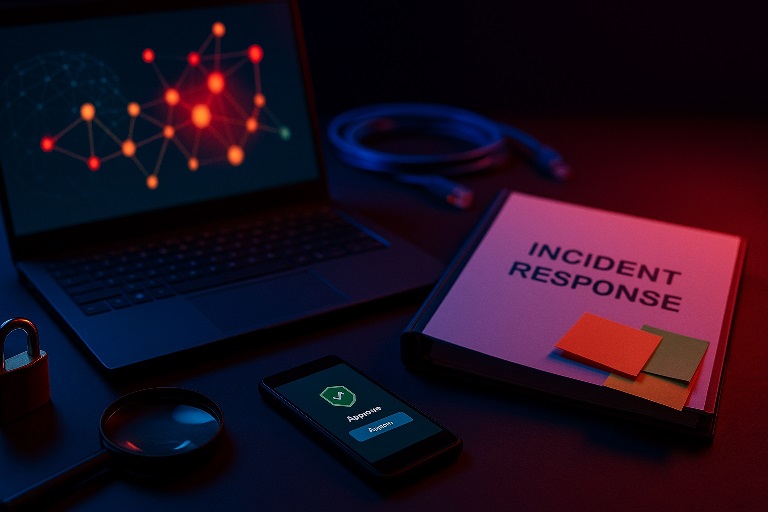
Modern attackers don’t just break systems—they outthink teams. That’s why critical thinking is the most underrated security control you can develop. Below is a practical, research-informed guide to sharpen analysis, pattern recognition, and decision-making so you can spot weak signals early and respond with confidence.
- Why critical thinking beats checklists
- Exercise 1: The Signal Hunt—separate noise from narrative
- Exercise 2: The Adversary Canvas—map capability, not just indicators
- Exercise 3: Bias Breaker Drills—train for mental pitfalls
- Exercise 4: Scenario Labs—short, realistic investigations
- Exercise 5: Red-Teaming Assumptions—break your own guardrails
- Exercise 6: The Pattern Flip—future-proof your detection logic
- Exercise 7: Decision Pre-Mortems—stress-test your choices
- Applying the exercises to real threats
- Implementation tips for lasting impact
- Conclusion
- FAQs
Why critical thinking beats checklists
Checklists help you pass audits; critical thinking helps you survive incidents. Current threat research shows adversaries moving faster, blending living-off-the-land techniques with automation and deceptive tradecraft—demanding analysts who can question assumptions and connect dots across telemetry, people, and process. Recent outlooks and threat reports flag rapid attacker adaptation, the growing use of automation, and expanding attack surfaces across cloud and identity, underscoring the need for analytical rigor at every tier of defense.
Exercise 1: The Signal Hunt—separate noise from narrative
Goal: Train your mind to resist first impressions and find the smallest clue that changes the whole story.
How to run it:
Pick a 24-hour slice of telemetry (EDR, identity, SaaS, network). Ask: If this were benign, what pattern would I expect? Then flip it: If this were malicious, what’s the minimum evidence I’d need to believe it? Create two short, competing narratives and argue against your favorite.
What you’ll strengthen: Hypothesis testing, bias checks, comfort with ambiguity.
Pro tip: As you build hypotheses, consult your threat intelligence notes last—not first—to avoid anchoring on an external narrative.
Exercise 2: The Adversary Canvas—map capability, not just indicators
Goal: Think like an operator, not a log reader.
How to run it:
Choose one active actor profile from a reputable annual report. On a whiteboard, sketch four boxes: Objectives → Access → Stealth → Constraints. Fill each with likely techniques and real-world frictions (time, cost, skills, tooling). Now ask: Where is the cheapest path to impact in our environment? That path points to controls worth revisiting.
What you’ll strengthen: Systems thinking, prioritization, resource-aware defense.
Why it matters: Reports highlight more “malware-free” tradecraft and identity compromise, which can bypass signature-first defenses.
Exercise 3: Bias Breaker Drills—train for mental pitfalls
Goal: Reduce false negatives caused by cognitive shortcuts.
How to run it:
Run weekly five-minute drills naming the bias, the trap, and the counter-move:
- Confirmation bias: You believe a login spike is a marketing campaign. Counter: Write the opposite case first.
- Availability bias: You just handled a credential-stuffing wave, so you over-index on it. Counter: Require three alternative hypotheses.
- Sunk-cost fallacy: You keep hunting a pet theory because of time spent. Counter: Set a “kill switch” timebox.
What you’ll strengthen: Metacognition under pressure.
Exercise 4: Scenario Labs—short, realistic investigations
Goal: Practice disciplined reasoning on incomplete data.
How to run it:
Twice a week, run 25-minute micro-scenarios. Start with a two-line inject (e.g., “Service account from Finance accessed object storage from a new ASN”). Your team must:
- list what’s known vs. unknown,
- design the smallest next query that could falsify the main hypothesis,
- state a decision with explicit risk trade-off.
What you’ll strengthen: Minimal-viable-evidence mindset; clear decision making.
Why it matters: Industry guidance emphasizes decision practice through tabletop formats that mirror evolving, layered incidents.
Exercise 5: Red-Teaming Assumptions—break your own guardrails
Goal: Identify blind spots created by well-meaning controls.
How to run it:
Pick a control you trust (e.g., SSO with device posture). Ask: If I had one evening to bypass this, what’s my plan? Document three bypass routes and test them in a safe lab. Then harden detections where your plan succeeded.
What you’ll strengthen: Creative problem solving; pragmatic defense-in-depth.
Exercise 6: The Pattern Flip—future-proof your detection logic
Goal: Design detections that survive attacker adaptation.
How to run it:
Take one successful detection. Strip all IOCs. Keep only the behavioral essence (sequence, frequency, context). Now re-implement the rule using signals that are costlier for an attacker to change (e.g., process relationships, time-based anomalies, identity risk). Validate against a month of logs to tune false positives.
What you’ll strengthen: Durable detection engineering aligned to evolving tradecraft noted in recent trend reports.
Exercise 7: Decision Pre-Mortems—stress-test your choices
Goal: Make better calls when seconds matter.
How to run it:
Before approving a high-impact change (blocking an ASN, pulling an appliance offline), ask the team to imagine the decision failed catastrophically. List the top five reasons why. Put mitigations in place now, not later.
What you’ll strengthen: Risk framing, option appraisal, and accountability.
Applying the exercises to real threats

To keep this grounded, anchor your practice to the current landscape: reports for 2025 highlight growth in identity-centric intrusions, faster exploitation cycles, and increased pressure on cloud and third-party dependencies. Align your drills to those realities and you’ll improve both time-to-detect and quality of response.
Implementation tips for lasting impact

Cadence and scope
Start small: two micro-scenarios per week, one bias drill, and a monthly adversary canvas review. Rotate ownership so every analyst practices facilitation, not just investigation.
Measurement
Track three metrics: (1) hypothesis-to-decision time, (2) number of alternative hypotheses considered, (3) post-exercise control changes shipped. Over 4–6 weeks, you should see sharper scoping and faster, more confident decisions.
Culture
Treat exercises as learning, not grading. Reward people who disconfirm their own theories, document uncertainty, and propose the next smallest test.
Conclusion
Technology evolves, but thinking scales. By practicing short, evidence-first exercises—signal hunts, scenario labs, bias breakers, adversary canvases—you’ll build a team that challenges assumptions, spots weak signals, and responds decisively. Grounding drills in current research and real attack paths keeps the work relevant—and your organization resilient.
FAQs
1) How long should a micro-scenario take to be effective?
Aim for 20–30 minutes. The timebox forces focus on the smallest next question and trains quick, defensible decisions.
2) What’s the best team size for these exercises?
Three to five people works well: one facilitator, one note-taker, and two to three investigators to avoid groupthink.
3) How do we keep scenarios realistic without exposing sensitive data?
Use de-identified logs and synthesized identities. Preserve timing, sequence, and context, but mask anything proprietary.
4) How often should we revisit the same scenario theme?
Quarterly. Re-running themes (identity misuse, lateral movement, exfiltration) reveals whether your improvements actually stick.
5) What artifact should every exercise produce?
A one-page debrief: the hypotheses considered, the minimal evidence gathered, the decision made, and the control changes queued. This becomes gold for onboarding and audit trails.


